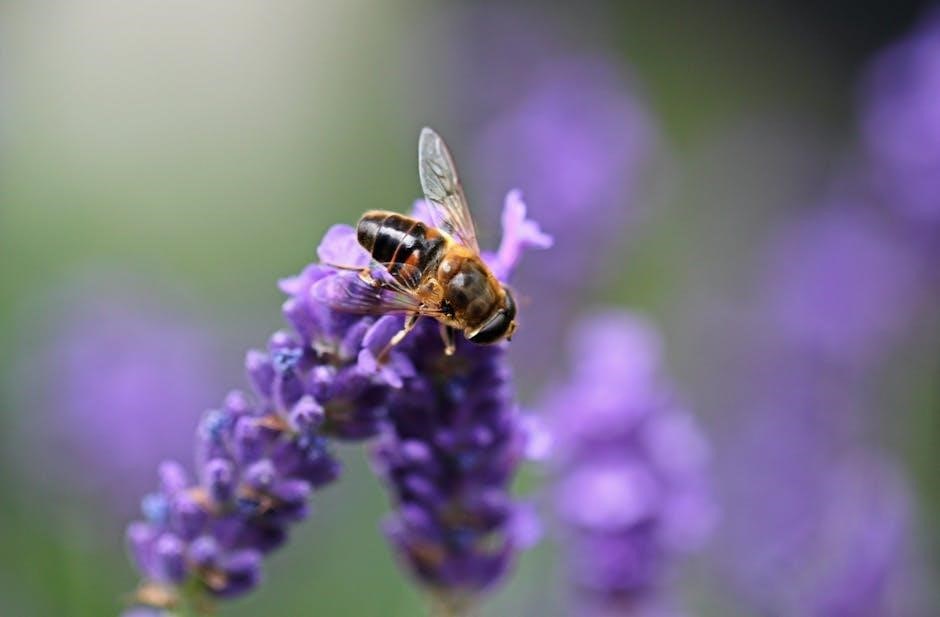Stingless bee hive design involves creating structures that mimic natural nesting sites‚ such as tree cavities‚ to support colony health and honey production․ This section explores the principles‚ materials‚ and innovations in designing hives for these unique pollinators‚ emphasizing sustainability and ecological harmony․
1․1 Importance of Hive Design for Stingless Bees
Effective hive design is crucial for the survival and productivity of stingless bee colonies․ Properly constructed hives provide optimal conditions for brood development‚ honey storage‚ and colony health․ They protect bees from pests‚ diseases‚ and extreme weather‚ while also ensuring efficient honey harvesting․ Well-designed hives‚ such as bamboo or log artificial hives‚ mimic natural nesting sites‚ promoting ecological balance and colony growth․ This design adaptability is vital for maintaining biodiversity and supporting pollination efforts in diverse climates and regions․
1․2 Brief Overview of Stingless Bee Biology
Stingless bees are highly social insects living in colonies with a single queen and thousands of worker bees․ They construct intricate nests using propolis‚ a resinous material‚ to create honeycombs for honey‚ pollen‚ and brood․ Unlike honey bees‚ they do not sting and are smaller in size․ Their colonies thrive in tropical and subtropical climates‚ relying on nectar and pollen for survival․ Understanding their biology is essential for designing hives that support their natural behaviors and ensure colony health and productivity․
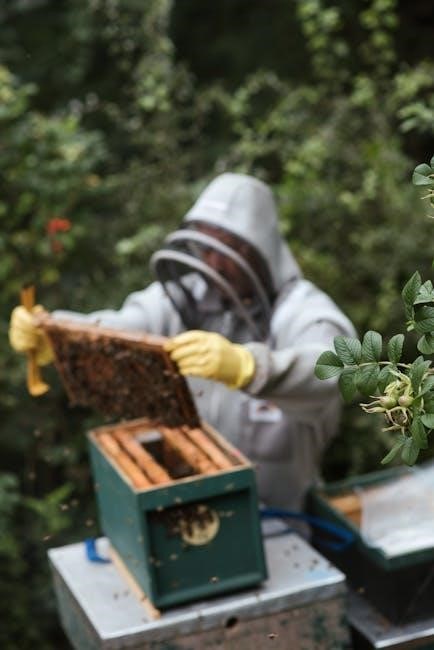
Understanding Stingless Bee Biology and Behavior
Stingless bees are social insects that thrive in colonies‚ constructing nests with propolis and wax․ Their behavior revolves around nectar and pollen collection‚ essential for survival․
2․1 Social Structure of Stingless Bees
Stingless bees live in highly organized colonies with a single queen responsible for reproduction․ Worker bees‚ all female‚ manage hive construction‚ foraging‚ and care for young․ Males‚ or drones‚ focus solely on mating․ This division of labor ensures colony survival and efficiency․ The queen’s pheromones regulate worker behavior‚ maintaining social order․ Colonies are tightly knit‚ relying on communication and cooperation to thrive in their intricate hive structures․
2․2 Nesting Habits and Natural Hive Construction
Stingless bees naturally nest in hollow tree trunks or branches‚ constructing intricate hives using propolis and wax․ Their nests feature spiral-shaped combs and separate chambers for brood and honey storage․ These structures are built collaboratively by worker bees‚ ensuring durability and efficiency․ The hive’s internal architecture reflects the colony’s social organization‚ with specific areas designated for different activities․ Understanding these natural habits is crucial for designing artificial hives that meet the bees’ needs and promote healthy colonization․
2․3 Colony Health and Hive Requirements
A healthy stingless bee colony relies on a hive design that regulates temperature‚ maintains humidity‚ and provides adequate space for brood and honey storage․ The hive must protect against pests and diseases while ensuring proper ventilation․ Natural materials and structures that mimic tree cavities are essential for maintaining colony health․ Additionally‚ the hive should allow for easy monitoring and management without disrupting the colony’s natural behaviors․ These requirements ensure the colony thrives and produces honey sustainably․
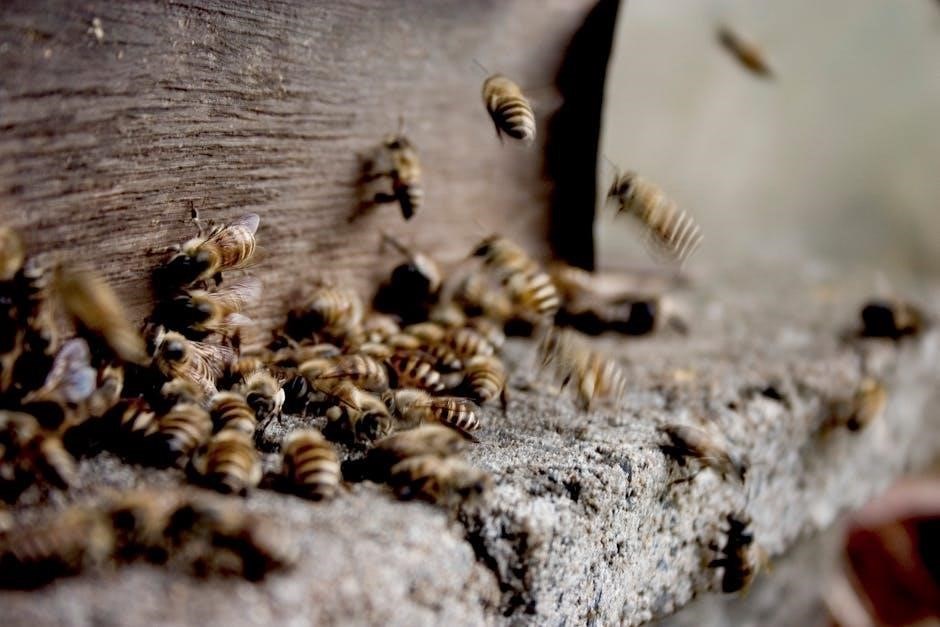
Historical Evolution of Stingless Bee Hive Design
The design of stingless bee hives has evolved from natural tree cavities to modern‚ sustainable structures․ Indigenous practices and innovations in materials have shaped hive construction over time․
3․1 Traditional Hive Designs and Methods
Traditional hive designs for stingless bees often mimic natural habitats‚ such as tree cavities‚ using materials like bamboo‚ wood‚ and propolis․ Indigenous practices emphasize sustainability‚ with hives crafted from locally sourced‚ biodegradable resources․ Early methods focused on minimal interference‚ allowing bees to build their nests naturally․ These designs prioritized colony health and honey production while maintaining ecological balance․ Traditional hives were often simple‚ consisting of hollow logs or carved wood‚ ensuring bees could thrive without modern interventions․ Such methods remain influential in contemporary stingless beekeeping‚ blending heritage with practicality․
3․2 Indigenous Practices in Hive Construction
Indigenous communities have long utilized natural materials like hollow logs‚ bamboo‚ and gourds to construct hives for stingless bees․ These traditional methods emphasize sustainability‚ often replicating the bees’ natural nesting habits․ Local knowledge and cultural practices guide hive construction‚ ensuring minimal environmental impact․ Indigenous techniques focus on preserving ecological harmony‚ with materials sourced responsibly to maintain biodiversity․ These practices highlight a deep understanding of stingless bee behavior and their role in pollination‚ blending tradition with practicality to support both bees and local ecosystems effectively․
Key Principles of Stingless Bee Hive Design
Principles include using natural materials‚ climatic adaptability‚ and space optimization for brood and honey․ Designs often incorporate indigenous practices‚ ensuring sustainability and colony health while promoting efficient honey harvesting․
4․1 Materials Used in Hive Construction
Natural materials like wood‚ bamboo‚ and plant fibers are commonly used in stingless bee hive construction due to their durability and sustainability․ Bamboo hives (BH) and log artificial hives (LAH) are popular choices‚ offering thermal regulation and ease of maintenance․ The UTOB hive design often incorporates recycled wood‚ ensuring eco-friendliness․ These materials mimic natural nesting sites‚ promoting colony health and honey production while aligning with conservation efforts․ Sustainable practices in material selection are crucial for the longevity of stingless bee colonies and their habitats․
4․2 Climatic Considerations for Hive Design
Hive designs must account for regional climates to ensure colony survival․ Tropical climates require hives with ample ventilation to prevent overheating‚ while temperate designs focus on insulation․ The Temperate Climate (TC) hive incorporates features like double-walled construction to retain heat․ Natural materials such as wood and bamboo are often used for their thermal properties․ Regional adaptations‚ such as the Ku-ring-gai hive‚ demonstrate how climate-specific designs enhance colony health and productivity‚ ensuring sustainability across diverse environments․
4․3 Space Management for Brood and Honey Chambers
Effective space management in hive design ensures balanced growth of brood and honey production․ Innovations like the UTOB hive feature separate chambers for honey storage and brood rearing‚ optimizing colony productivity․ Movable frames allow beekeepers to expand or modify hive capacity without disrupting the colony․ This design prevents overcrowding‚ reducing stress on bees and promoting healthy hive dynamics․ Such spatial organization is crucial for maintaining colony health and maximizing honey yields while ensuring the bees’ natural behaviors are supported․ Proper space management is a cornerstone of successful stingless beekeeping․
4․4 Incorporating Natural Nesting Behaviors
Stingless bees naturally nest in tree cavities‚ so hives should mimic these environments․ Designs often use wood and internal structures that replicate natural nesting sites‚ including propolis-lined chambers․ Vertical frames and honeycomb patterns align with their instinctual behavior‚ promoting efficient brood rearing and honey storage․ Entrance tunnels and chamber layouts are crafted to mirror tree hollows‚ ensuring bees can regulate temperature and humidity․ By integrating these natural elements‚ hives support the bees’ innate habits‚ fostering a healthy and productive colony environment that aligns with their evolutionary instincts․
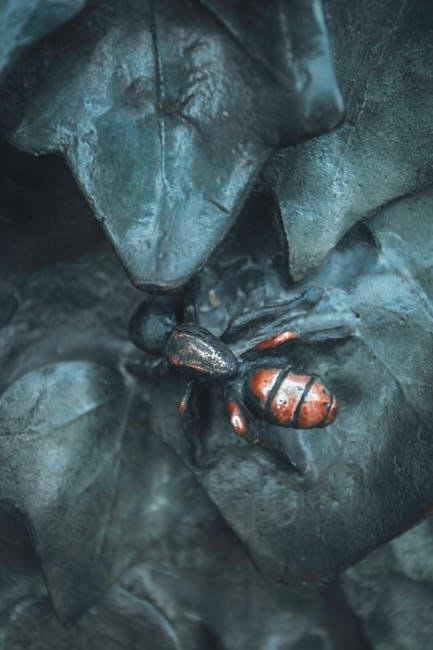
Types of Stingless Bee Hives
Stingless bee hives are categorized into natural‚ bamboo‚ and log artificial designs․ Natural hives (NH) mimic tree cavities‚ while bamboo hives (BH) use sustainable materials․ Log artificial hives (LAH) blend traditional and modern methods‚ ensuring colony establishment․ Each design reflects regional adaptations and beekeeping practices‚ providing diverse options for beekeepers to suit various climates and conservation goals․
5․1 Natural Hives (NH) and Their Advantages
Natural hives (NH) are designed to mimic the bees’ native nesting sites‚ such as tree cavities‚ ensuring minimal disturbance to their natural behavior․ These hives are eco-friendly‚ promoting colony health by maintaining the bees’ instinctual habits․ NH designs are often low-maintenance and cost-effective‚ making them ideal for small-scale beekeeping․ They also encourage sustainable practices‚ aligning with conservation efforts․ By replicating natural environments‚ NH hives support robust colony growth and honey production‚ making them a popular choice among beekeepers aiming to preserve stingless bee ecology․
5․2 Bamboo Hives (BH) for Sustainable Beekeeping
Bamboo hives (BH) offer an eco-friendly alternative for stingless beekeeping‚ utilizing renewable materials that align with sustainable practices․ These hives are designed to mimic the natural habitats of stingless bees‚ providing a durable and biodegradable structure․ Bamboo’s natural properties help regulate hive temperature and humidity‚ promoting colony health․ BH hives are cost-effective and environmentally friendly‚ making them a popular choice for beekeepers aiming to reduce their ecological footprint while supporting pollinator conservation and honey production․ Their simplicity and sustainability make BH hives a key option for eco-conscious beekeeping initiatives․
5․3 Log Artificial Hives (LAH) for Colony Establishment
Log Artificial Hives (LAH) are specifically designed to mimic the natural nesting habits of stingless bees‚ using logs as the primary material․ These hives provide a structured environment with internal cavities that encourage colony establishment and growth․ LAH hives are cost-effective‚ easy to maintain‚ and ideal for beekeepers looking to establish new colonies․ Their design supports the natural behavior of stingless bees‚ ensuring a healthy and thriving hive․ This method is particularly favored for its simplicity and effectiveness in promoting colony prosperity while maintaining ecological balance․
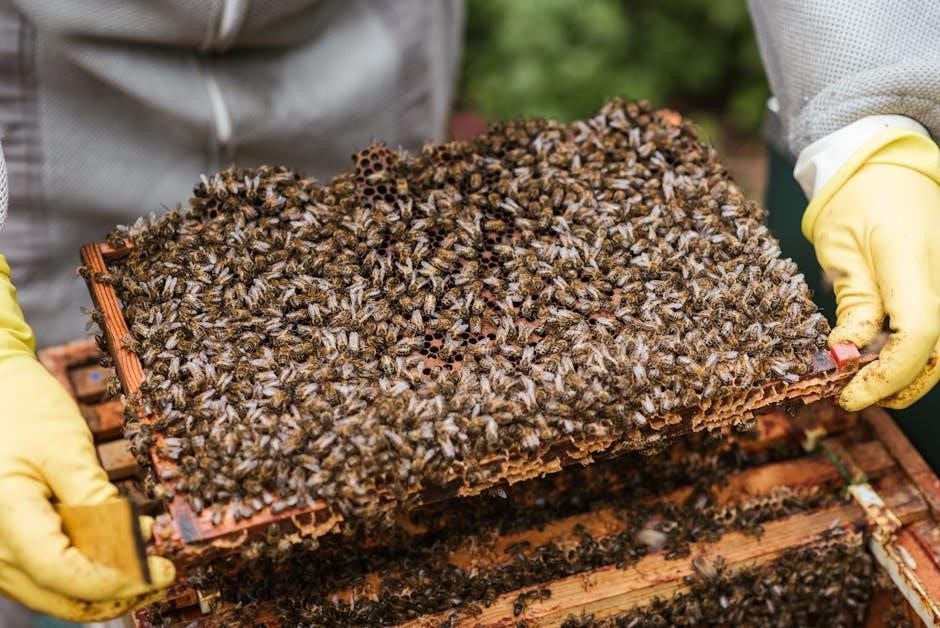
Comparing Hive Designs for Different Climates
Stingless bee hive designs vary by climate‚ with tropical hives emphasizing breathability and temperate designs focusing on insulation․ Regional adaptations ensure optimal colony survival and honey production․
6․1 Hive Designs for Tropical vs․ Temperate Climates
Stingless bee hives differ significantly in design based on climate․ Tropical hives often use lightweight‚ breathable materials like bamboo‚ emphasizing ventilation to withstand high humidity and temperatures․ In contrast‚ temperate designs focus on insulation‚ incorporating wood and layered structures to protect colonies from cold winters․ The UTOB hive‚ for instance‚ features an insulated top box‚ while the Temperate Climate (TC) hive mimics natural nesting sites with adjustable frames and insulation layers to maintain stable internal conditions‚ ensuring colony survival in diverse environments․
6․2 The Temperate Climate (TC) Hive Design
The Temperate Climate (TC) hive is specifically engineered for regions with cooler temperatures․ It features an insulated structure with a focus on maintaining stable internal temperatures and humidity levels․ Unlike tropical designs‚ the TC hive incorporates materials like wood and insulation to protect colonies from harsh winters․ Its design includes adjustable frames and a unique honey storage compartment that can be accessed without disturbing the brood area‚ ensuring colony health and productivity in temperate zones․ This hive is a result of studying natural nesting behaviors in such climates‚ optimizing for survival and honey production․
6․3 Regional Adaptations of Hive Designs
Regional adaptations of stingless bee hive designs ensure optimal performance in diverse climates and environments․ In tropical regions‚ hives often incorporate natural materials like bamboo and logs‚ blending seamlessly with local ecosystems․ In contrast‚ temperate climates require hives with enhanced insulation and protective features to withstand colder conditions․ Designs like the TC hive and UTOB hive exemplify these adaptations‚ ensuring colony survival and productivity․ Such regional tailoring supports biodiversity and pollination efforts‚ making stingless beekeeping viable across various geographical locations while respecting local ecological conditions․
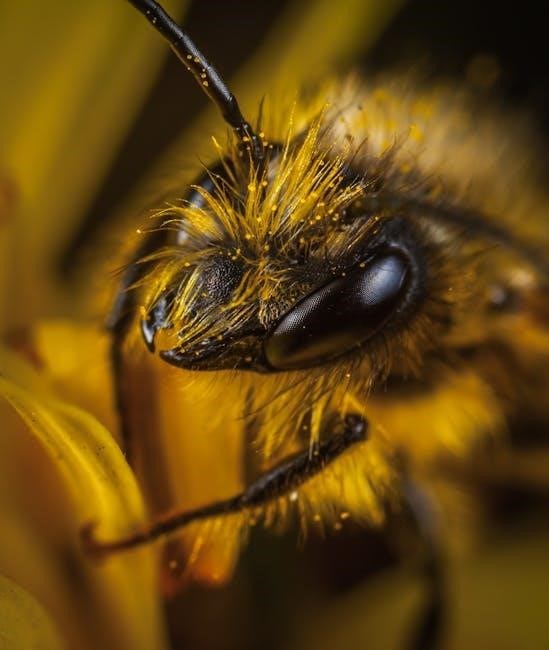
Construction and Maintenance of Stingless Bee Hives
Constructing and maintaining stingless bee hives involves using sustainable materials like bamboo and logs‚ ensuring proper insulation and space for colony growth‚ while regular checks prevent pests and diseases‚ promoting healthy hive conditions and productivity․
7․1 Materials and Tools Required for Hive Construction
Constructing stingless bee hives requires sustainable materials like bamboo‚ hollow logs‚ or untreated wood․ Tools include saws‚ drills‚ and chisels for shaping‚ while natural sealants like propolis or beeswax ensure hive integrity․ Frames and chambers are designed to mimic natural nesting sites‚ with precise spacing for brood and honey storage․ Protective gear like gloves and veils are essential for safe handling‚ while smokers may be used to calm bees during maintenance․ Properly sterilized equipment prevents disease spread‚ ensuring a healthy environment for the colony to thrive․
7․2 Step-by-Step Guide to Building a Stingless Bee Hive
Building a stingless bee hive involves selecting sustainable materials like bamboo or untreated wood․ Begin by measuring and cutting the wood to desired dimensions․ Assemble the hive body‚ ensuring proper ventilation and spacing for brood and honey chambers․ Attach frames or compartments‚ mimicking natural nesting structures․ Create a narrow entrance to protect the colony from predators․ Apply natural sealants like beeswax or propolis to secure joints․ Finally‚ install the hive in a shaded‚ sheltered location‚ ensuring easy access for monitoring and maintenance․ This design supports colony health and productivity․
7․3 Maintenance Practices for Optimal Colony Health
Regular inspections ensure hive cleanliness and detect issues early․ Check for pests‚ diseases‚ and damage‚ treating promptly if necessary․ Maintain proper ventilation to prevent moisture buildup․ Harvest honey responsibly‚ leaving enough for the colony․ Seasonally clean frames and entrances‚ removing old propolis․ Provide a safe‚ shaded location and protect from extreme weather․ Avoid chemical treatments‚ using natural methods to control pests․ Monitor hive weight and activity‚ ensuring adequate food sources․ These practices promote a healthy‚ thriving colony and maximize productivity․

Harvesting Honey from Stingless Bee Hives
Harvesting honey from stingless bee hives requires careful extraction to avoid harming the colony․ Methods include removing honey chambers and straining without damaging combs‚ ensuring sustainability․
8․1 Methods for Harvesting Honey Without Harm
Harvesting honey from stingless bees involves carefully extracting the honey storage compartment to avoid damaging the hive or harming the colony․ The process typically includes removing the honeycomb frames‚ gently brushing off bees‚ and straining the honey to remove debris․ This method ensures minimal disruption to the bees’ natural habits and preserves the integrity of the hive․ Advanced hive designs‚ such as the UTOB hive‚ allow for easy removal of the honey section‚ making the harvesting process more efficient and bee-friendly․ Proper handling ensures high-quality honey production while maintaining colony health․
8․2 Processing and Packaging Honey for Sale
Processing involves straining raw honey to remove impurities while preserving its natural properties․ The honey is then packaged in food-safe‚ airtight containers to maintain quality and freshness․ Proper labeling‚ including origin and nutritional information‚ is essential for market compliance․ Packaging materials should be sustainable and durable to protect the honey during distribution․ Community-based initiatives often emphasize eco-friendly practices to align with the conservation goals of stingless beekeeping․ This step ensures the honey reaches consumers in optimal condition‚ supporting both bee health and commercial success․

Case Studies and Successful Hive Designs
Successful hive designs‚ such as the UTOB and Ku-ring-gai models‚ demonstrate how innovative structures improve colony survival and honey production‚ supporting sustainable beekeeping practices globally․
9․1 The UTOB Hive Design and Its Efficiency
The UTOB hive design is renowned for its efficiency in stingless beekeeping‚ featuring a removable honey storage compartment for easy harvesting․ Unlike traditional hives‚ the UTOB design emphasizes simplicity and adaptability‚ making it suitable for various climates․ Its structure supports colony health by maintaining optimal temperature and humidity levels‚ crucial for stingless bees․ This design has been widely adopted in conservation programs‚ such as the Ku-ring-gai initiative‚ showcasing its effectiveness in promoting sustainable beekeeping practices and enhancing honey production without harming the colony․
9․2 Ku-ring-gai Program and Hive Innovations
The Ku-ring-gai program focuses on biodiversity through native bee conservation‚ introducing innovative hive designs like the retrofit box․ This design improves upon traditional hives‚ such as the OATH (Original Australian Timber Hive)‚ by addressing climatic and ecological needs․ The program emphasizes sustainable practices‚ promoting stingless beekeeping as a tool for environmental conservation․ Its success has inspired community-based initiatives‚ showcasing the potential of adapted hive designs to support pollinator health and ecosystem balance‚ while educating the public on the importance of native bees․
9․3 Community-Based Stingless Beekeeping Initiatives
Community-based stingless beekeeping initiatives‚ like the Cumberland City Council’s “Keepin-A-Hive” program‚ focus on biodiversity conservation through native bee pollination․ These programs often involve designing and distributing specialized hives‚ such as the retrofit box‚ to engage residents and educators․ By promoting sustainable beekeeping practices‚ these initiatives foster environmental awareness and community involvement․ They also support local economies by encouraging the production and sale of stingless bee honey and related products‚ creating a tangible connection between conservation and livelihoods․
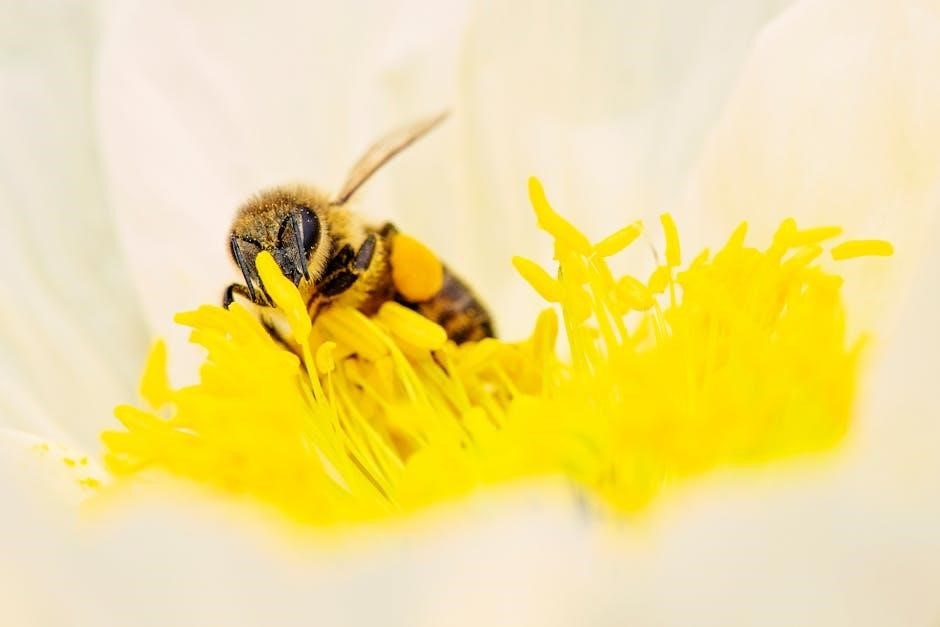
Challenges in Stingless Bee Hive Design
Challenges in stingless bee hive design include maintaining optimal temperature and humidity‚ preventing disease outbreaks‚ and adapting designs to mimic natural nesting behaviors effectively․
10․1 Common Issues in Hive Construction
Common issues in stingless bee hive construction include ensuring proper ventilation‚ maintaining optimal temperature and humidity‚ and preventing pest infestations․ Materials must be durable yet natural‚ as synthetic substances can harm colonies․ Designing hives that mimic natural nesting sites is challenging‚ as stingless bees are highly sensitive to environmental changes․ Additionally‚ hive construction must balance colony health with honey production‚ requiring precise space management for brood and honey chambers․ Addressing these issues is critical for successful hive design and colony survival․
10․2 Mitigating Colony Death and Disease
Preventing colony death and disease requires careful hive design and maintenance․ Proper ventilation and temperature control are essential to prevent moisture buildup and fungal growth․ Durable‚ non-toxic materials should be used to avoid chemical contamination․ Regular monitoring for pests and pathogens is crucial‚ and hives should be designed to facilitate easy inspection․ Additionally‚ ensuring adequate space for brood and honey chambers helps reduce stress on the colony‚ promoting overall health and resilience against diseases․

Future Trends in Stingless Bee Hive Design
Future trends include smart hive sensors‚ eco-friendly materials‚ and 3D printing for customization‚ enhancing colony health and honey production while integrating conservation efforts․
11․1 Innovations in Hive Materials and Technology
Recent advancements in hive materials include sustainable options like bamboo and recycled wood‚ reducing environmental impact․ Smart hive sensors now monitor temperature‚ humidity‚ and hive activity‚ enabling real-time colony management․ Innovations like 3D-printed hives offer customized designs for specific climates and bee species․ Additionally‚ the integration of IoT technology allows beekeepers to track hive health remotely‚ improving efficiency and reducing colony stress․ These cutting-edge solutions aim to enhance colony survival and honey production while promoting eco-friendly beekeeping practices globally․
11․2 Integrating Hive Design with Conservation Efforts
Integrating hive design with conservation efforts focuses on preserving natural habitats and promoting biodiversity․ Modern hive designs often incorporate eco-friendly materials and techniques that minimize environmental disruption․ Community-based initiatives and educational programs encourage sustainable beekeeping practices‚ aligning with broader conservation goals․ By designing hives that mimic natural nesting sites‚ beekeepers help protect pollinators and their ecosystems․ This approach not only supports stingless bee populations but also contributes to the overall health of ecosystems‚ making conservation a core principle of contemporary hive design strategies․
